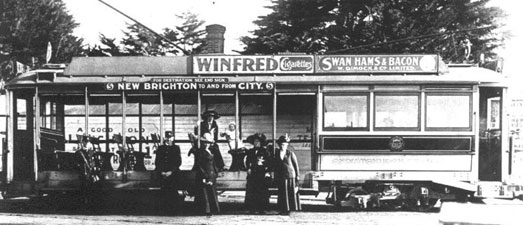
The intent of this project is to restore Christchurch Hills Tramcar No. 24 and Dreadnought trailer No. 118 to operating condition, and (probably) to the same era as a matching set to demonstrate how these two vehicles would have operated together in the latter days of their operation under the Christchurch Tramways Board.
Restoring these two vehicles as a pair in the form they run in the latter days of their operation would also provide the Tramway Historical Society with two fully enclosed vehicles able to seat over 100 passangers. This would also mean they may be more suited for use by the Tamaki Maori Village operation during inclement weather than the existing trams on the Ferrymead Tramway which are also somewhat open.
Currently (mid 2008) work is progressing on the Conservation Plan, which is required as a pre-requisite prior to any restoration work being undertaken.
The Conservation Plan will document and identify for each of the two vehicles
Once the Conservation Plan is complete, this will be used to determine/confirm the era to which the Trams will be restored, and be used as a document to support fund raising efforts and to support the restoration proper once it starts.
At this time, a plan for undertaking the restoration will also be drawn up, including timeframe.
At its meeting on 7th September 2007, the Lottery Environment and Heritage Committee of the NZ Lottery Grants Board awarded the Tramway Historical Society Inc approved a grant of $10,000.00 towards the production of a conservation plan for the Hills Tramcar No 24 and Dreadnaught trailer No. 118.
A small number of members of the Tramway Historical Society have also made some donations tomwards this project.
Following is a background on these two vehicles and their significance, submiited by the Tramway Historical Society Inc as part of the grant application to the NZ Lottery Grants Board.
The Society has in the past restored some of the glamour cars which served the city – and because of the historic appeal has taken some of these cars back to an earlier, although authentic style, examples of this being double decker 26, California No1 and Boon 152.
The significance of 24 and 118 as a pair is that they represent the “workhorses” which are the backbone of a public transport system. Although modernised and adapted over the years to meet passengers' increasing expectations of comfort, these two cars represent classes of tramcar which survived in service over many years with only minor modifications. Some Christchurch tramcars were rebuilt out of all recognition over the years. The bodies of these two cars are in their final configuration and it is in this form that they operated in Christchurch for many years – essentially from the 1920s until the 1950s.
It is intended that these cars be restored into their latter day style as this is how generations of Christchurch commuters knew and still remember these cars.
No. 118 is a bogie or 8-wheel trailer, the only such car to have survived. Trailer operation was a distinctive feature of the Christchurch tramway system, giving the trams a unique train-like appearance which greatly fascinated visitors to the city. Christchurch being almost completely flat, lent itself to trailer operation. The steam trams, which commenced running in 1880, introduced trailers to Christchurch. When the tramway system was electrified from 1905, the practice of running trailers was simply continued.
Christchurch, despite its flatness, had one horrendous hill, climbed by trams from 1912 until 1953 up gradients as steep as 1 in 9 on an ascent which climbed over 600 vertical feet. Such a hill required special tramcars with special brakes – and was, of course, out of bounds for trailer operation.
Tramcar 24 and trailer 118 are two of the cars which provided service on this hill route – the Cashmere line. A matching pair in active service, it is now proposed to restore them as a tram and trailer set for heritage service, to recapture the unique flavour of the Christchurch electric tramway service in the first half of the twentieth century.
Open cars were an inheritance from the original American cars used in Christchurch from 1905, but were more suitable for California than the South Island of New Zealand. The Christchurch Tramway Board found a simple solution to this dilemma - it built its cars in the 1910 to 1920 period as romantically elegant open sided cars, but provided flexible side walls and windows which could be slid up into the roof of the cars if open cars were required . They could also be relatively quickly converted into enclosed cars and thus become practical workhorses if this were required because of the weather... It is into this convertible style that the Society proposes to restore these two historic cars.
As well as illustrating a direct response to local conditions, this enclosed style is practical and reflects a very real need on the Society's museum tramway at Ferrymead Heritage Park. Our present restored rolling stock illustrates well the elegant open design of Edwardian tramcars., but our passengers' comfort on a cold and blustery Christchurch day requires a practical workhorse with enclosed sides to keep passengers out of the wind and rain.
Christchurch weather can also be very hot in summer – up to 37 degrees C – and this heat can change in the timespan of half an hour into a southerly gale with slashing rain or hail and even on extreme and rare occasions into snow. A fall in temperature from 30 degrees or more to 10 degrees in a few minutes is quite common. The Christchurch Tramway Board – the former operators of these cars – had a very simple solution to this weather dilemma: they simply designed open cars which were convertible and could be readily changed into enclosed cars on cold days and open cars on hot days! Crinkly sided aluminium walls and glass windows – so welcome on cold days - were simply slid on runners up into the roof! Lo and behold, a glorious open car, miraculously created on a hot day by a mere tram conductor to keep passengers comfortable in all the vagaries of the strange weather Christchurch can have.
Faced with the problem of cars which never seemed to suit the weather and with days in which the weather never ended up the way it began, the Christchurch Tramway Board came up with its own unique Christchurch solution to a uniquely Christchurch problem – convertible tramcars.
Tramcar No. 24 and trailer No. 118 are typical examples of these unique trams.
The concept was copied by the Dunedin City Council in its Sydney-built “Sydney Bogie” tramcars of 1921.
The original ten “Hills” cars were built in 1912 for the new tram line up the Cashmere hills, a very fashionable and developing residential area. These cars were locally built. Body work was constructed by Boon and Company, a local tramcar and coach building firm, in Ferry Road, Christchurch and it is likely that the bogies were also locally made.
These cars were fitted with more powerful motors for better performance on the 1 in 9 gradient in Hackthorne Road than were cars built for operation on flat routes only and had air operated track brakes for emergency use on this steep route.
No. 24 was one of three additional “Hills” tramcars built in 1920 for the Christchurch Tramway Board by Boon and Company, using electrical and mechanical equipment salvaged from three withdrawn double decker cars dating from 1905. In virtually all respects these cars were the same as the original ten cars, except for some small interior details.
No. 24 remained in service until shortly before the closure of the tramway system.
Improvements were made to these cars over the years in areas such as streamlining the end destination boxes and the addition of leather padded seat squabs.
Photo’s of Tramcar 24: The first photo is of a typical Hills car in its original configuration.

The following photo is of 24 outside the “Sign of the Takehe” at the terminus of the Cashmere line. Tramcar 24 is likely to restored to an enclosed configuration similar to its appearance in this photograph.
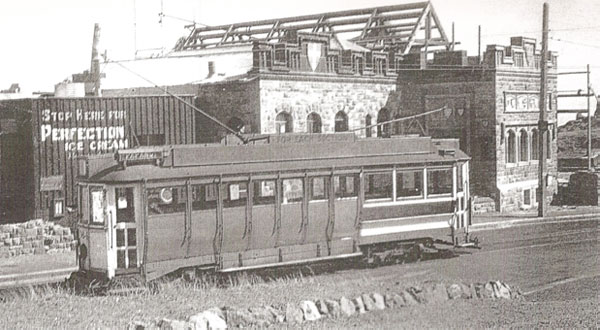
The following photo is of the body of Tramcar 24 that is currently in storage awaiting restoration at the Tramway Hisorical Society’s Trambarn at the Ferrymead Tramway in Christchurch.
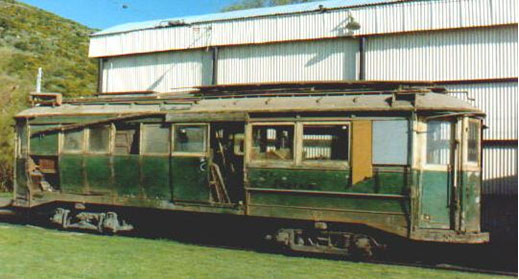
The following two photos show the interior of Tramcar 24 being cleaned out as part of researching the conservation plan, and a display of photographs of the vehicle and others of its class in service.
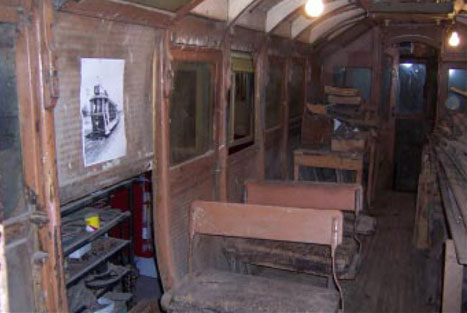
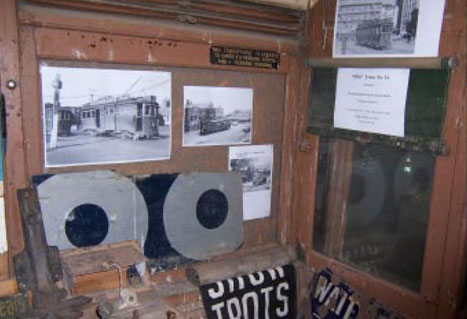
No. 118 was one of four trailers built by Boon and Company in 1911 for the Christchurch Tramway Board. Nicknamed “Dreadnought” trailers for their ability to swallow up a crowd, these cars seated 65 passengers as originally built. The unusual internal bearing bogies were made by a local firm Cooper and Duncan.
The trailers would operate with the “Hills” cars over the flat portion of the route but, being unmotored, could not be taken up the hill. Accordingly, a lengthy trailer siding was provided at the Barrington Street stop at the foot of the hill and here the trailer car would be left until next needed, while the “Hills” car proceeded up the hill to the terminus. Any passengers on the trailer wishing to proceed further than Barrington Street would simply transfer themselves to the front car while the trailer was being shunted off. This shunting could, at times, become quite a complicated operation, as was the re-coupling of the tram to a trailer after the descent from the hill. It was a uniquely Christchurch way of increasing the passenger carrying capacity of a busy tram line.
The “Dreadnought” trailers operated on the Cashmere line from its opening until their withdrawal from service in the early 1950s.
Photo’s of “Dreadnought” trailer 118. The first photo is of a typical “Dreadnought” trailer in its original open configuration.

The following photo is of a “Dreadnought” 121 trailer – an identical vehicle to 118 in an enclosed configuration. 118 is likely to be restored to a similar configuration.
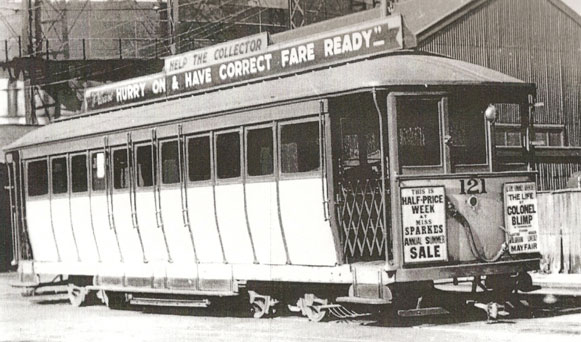
The following photo is of the body of “Dreadnought” trailer 118 that is currently in storage at the Tramway Historical Society’s Trambarn at the Ferrymead Tramway in Christchurch awaiting restoration to its former glory.
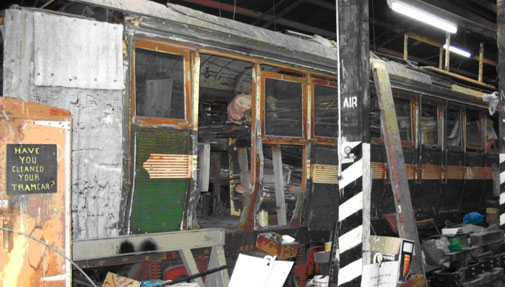
[End of Project Description]